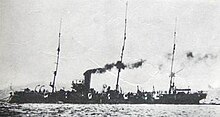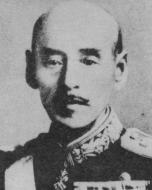Murakami Kakuichi
Murakami Kakuichi ( Japanese. 村上 格 一 ; * November 1, 1862 in what is now Saga Prefecture ; † November 15, 1927 ) was a Japanese admiral in the Imperial Navy , who was Minister of the Navy from January to June 1924 .
Life
Military training and naval officer
Murakami Kakuichi, childhood name Kesanosuke, son of a samurai of the Saga Han (now Saga Prefecture) and adopted son of Rear Admiral Murakami Chonosuke, began as a midshipman and participants of the 11th course on 10 September 1880 his studies at the Imperial Japanese Navy Academy (Kaigun Heigakkō) in Tsukiji and from October 14, 1883 on the training ship Tsukuba . After he had completed the training as the 2nd of 26 participants, he was promoted to ensign at sea on December 22, 1883 . After his promotion to lieutenant at sea (Shōi) on September 1, 1886, he was transferred to the corvette Yamato on September 6, 1886, and then to the paddle steamer Jingei on November 22, 1886 . Subsequently, on April 9, 1888, he was initially deputy section officer on the corvette Tenryū and on June 20, 1888, deputy section officer on the protected cruiser Takachiho , before he was transferred to the Naval Academy as a torpedo instructor on April 12, 1889. There he was promoted to captainleutnant ( Daii ) on August 28, 1889 and remained at the Naval Academy until November 26, 1890, where he was also the commander of the cadet division since November 19, 1889. He then acted between November 26, 1890 and December 21, 1892 as secretary to the commander-in-chief of the riot fleet and then as a section officer and instructor on the Jingei , before he was transferred as an officer to the protected cruiser Yoshino on March 27, 1893 . On this he took part in a voyage to the United Kingdom and had been Chief Torpedo Officer of this ship since June 7, 1893, with whom he took part in the Pungdo Battle on June 25, 1894 after returning on March 6, 1894 and during the First Japanese Took part in the sea battle of Yalu on September 17, 1894 during the Chinese War .

After Murakami was secretary and adjutant to Navy Minister Admiral Saigō Tsugumichi from March 1, 1895 to June 26, 1897 , he completed a degree in France on June 26, 1897 and during this time was initially corvette captain (Shōsa ) and then promoted to frigate captain (Chūsa) on October 1, 1898 . After completing his studies, he remained from April 25, 1899 to May 20, 1900 as a naval attaché at the legation in France and, on his return on September 1, 1900, was initially transferred to the staff of the standby fleet as an officer. He then worked from June 7, 1901 to November 1, 1902 as an adjutant on the staff of the Yokosuka Marine District. Afterwards he became deputy commander of the tower ship Chin'en on November 1, 1902 , before he took over his first command of the ship on July 7, 1903 as commander of the cruiser Chiyoda . In this use took place on September 26, 1903, his promotion to the sea captain (Daisa) . As commander of the Chiyoda he took part in the battle of Tschemulpo on February 9, 1904 , on August 10, 1904 in the naval battle in the Yellow Sea and on August 14, 1904 in the naval battle at Ulsan during the Russo-Japanese War .
Subsequently, Murakami took over the post of commander of the armored cruiser Azuma on January 12, 1905 and also took part in the naval battle at Tsushima from May 27 to 28, 1905 , which ended with a devastating defeat on the Russian side and was decisive for the The outcome of the Russo-Japanese War was. Subsequently, he was first between August 5, 1905 and April 7, 1906 head of Department 1 of the Naval Training Command and then from April 7, 1906 to August 28, 1908 adjutant in the Ministry of the Navy.
Promotion to Admiral and Minister of the Navy
After his promotion to Rear Admiral (Shōshō) Murakami was on August 28, 1908 Head of Departments 1 and 2 of the Naval Training Command and held these functions until December 1, 1909. He was also in personal union from July 19, 1909 to December 1 1912 Head of Department 1 of the Naval Shipbuilding Command. On December 1, 1912 Murakami was promoted to Vice Admiral (Chūjō) and took over as such until April 17, 1914 the post of director of the naval shipyard Kure . After being in a waiting position from April 17 to May 23, 1914, he became director of the Naval Shipbuilding Command on May 23, 1915. He then acted briefly from October 1 to December 13, 1915 as director of the naval engineering command and as a member of the Admiralty Committee, before becoming commander-in-chief of the 3rd Fleet, which was re-established in the course of the First World War , on December 13, 1915 . He held this post until his replacement by Vice Admiral Arima Ryōkitsu on April 6, 1917 and was then director of the Naval Training Command between April 6, 1917 and December 1, 1919.
During this time Murakami Kakuichi was promoted to Admiral (Taisho) on July 2, 1918 and served from December 1, 1919 to July 27, 1922 as commander in chief of the Kure Naval District, before he was subsequently a member of the Naval Council. On January 7, 1924, he was appointed by Prime Minister Kiyoura Keigo as Minister of the Navy in his cabinet , to which he was a member until the end of Kiyoura's term on June 11, 1924. He then belonged again to the Marinerat from June 11 to December 10, 1924, before he was transferred to the reserve on December 16, 1924 after a brief wait.
Background literature
- Denis Warner, Peggy Warner: The Tide at Sunrise: A History of the Russo-Japanese War, 1904-1905 , Charterhouse, 1974
- Trevor N. Dupuy : Encyclopedia of Military Biography , IB Tauris & Co Ltd., 1992, ISBN 1-85043-569-3 .
- J. Charles Schencking: Making Waves: Politics, Propaganda, And The Emergence Of The Imperial Japanese Navy, 1868-1922 , Stanford University Press, 2005, ISBN 0-8047-4977-9 .
Web links
- Entry on Imperial Japanese Navy
| personal data | |
|---|---|
| SURNAME | Murakami, Kakuichi |
| ALTERNATIVE NAMES | 村上 格 一 (Japanese) |
| BRIEF DESCRIPTION | Japanese admiral and politician |
| DATE OF BIRTH | November 1, 1862 |
| PLACE OF BIRTH | today: Saga Prefecture |
| DATE OF DEATH | November 15, 1927 |
